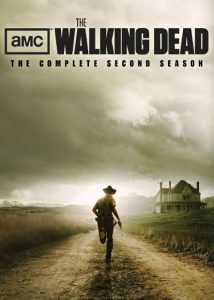Kind of a jerk move by Shane to kill Otis on Sunday’s episode of “The Walking Dead” (8 p.m. Central Sundays on AMC), huh? But also a shocking and fascinating one, and something that could set up TV’s next great “fall to the dark side” plot.
To recap: Shane — being pursued by a pack of zombies as he lugs valuable equipment and medicine that could save young Carl’s life — shoots his colleague Otis in the knee. As such, the zombies converge on Otis and Shane escapes with the supplies and gets the anesthetic and respirator back to the doctor in time to save Carl’s life. But the moral implications are more than a bit sketchy: He kills Otis to save Carl — and himself. There was no guarantee that killing Otis would save Carl. And there was still a chance (albeit slim) that he could escape the zombies with Otis and still save Carl.
Fans are coming down on all sides of this argument. Refreshingly, 61 percent of respondents to a “Talking Dead” poll said they would not have shot Otis. I fall into that group for a few reasons:
1. There was still a slim chance of escape.
2. In most circumstances, it is not appropriate to trade one life for another life. Certainly, it’s not Shane’s decision to make.
3. If Shane had helped Otis out of this jam, he would’ve had a friend for life, and a great story to tell the rest of the gang.
Thanks to the wonderful performance by Jon Bernthal, we see that Shane is a changed man when he gets back to the doctor’s cabin. He leaves the story of what happened unfinished and vague (as viewers, we see what actually happened in a flashback), stuttering in shame and shock at what he’d done; the others interpret it as the aftereffects of fear and adrenaline, no doubt. Then he shaves his head, which serves a dual purpose: He doesn’t have to explain the patch of hair that Otis had torn out, and it visually signifies to viewers that he’s a cold, hard man now who is all about survival.
I love me a good “turn to the dark side” yarn, and this is certainly shaping up to be the best one of the moment. And there are no shortage of “good people gone (potentially) bad” yarns on TV right now:
- On “Ringer,” Bridget is starting to get attached to her comfortable new life as Siobhan; to what lengths will she go to keep this life?
- On “The Secret Circle,” Faye enjoys her witch powers a little too much, and (as we were told last week) Cassie has a lot of dark power in her.
- On “Revenge,” Emily is taking down bad people in her vengeance quest. But what will she do when good people get in the way? Are they just collateral damage?
- On “American Horror Story,” Ben — for self-serving reasons — doesn’t turn in the guy who murders his mistress. Instead, he buries her under the gazebo, making himself an accessory after the fact.
These stories merely delve into the gray areas between good and evil, though. Shane commits the morally repugnant act of killing Otis, an act that almost always leads down the slippery slope to outright evil.

To wit:
One of the most famous falls to the dark side is Anakin Skywalker — indeed, “Star Wars” is the reason I use “dark side” as a convenient term. Anakin’s fall was either horribly or brilliantly told. On one hand, when he slaughters innocent, adorable Jedi younglings in “Episode III — Revenge of the Sith,” it’s annoying, revealing a unforgivable level of gullibility for doing what the Emperor tells him to do without questioning it.
On the other hand, it’s so shocking and hard to believe that I long to understand what Anakin was thinking. I enjoyed Matthew Stover’s “Revenge of the Sith” novelization, which is essentially an attempt to rectify the poor writing and acting of the movie, and I watch “The Clone Wars” in part to find signs of Anakin’s instability, as if that will make the slaughter-of-children scene more believable.
While the “Star Wars” franchise (including the books and comics) is obsessed with falls to the dark side, I don’t know if there’s been a single auteur who delves into this theme more than Joss Whedon, nor is there anyone better at exploring it. On “Buffy” and “Angel,” there are no less than five iconic falls from grace:
- The remorse-filled Angel turns into the evil, remorseless Angelus when his soul leaves his body. This character is fascinatingly ambiguous, because it seems like Angel and Angelus are largely different people inhabiting the same body. Yet even the good Angel has signs of Angelus in him (note “Enemies,” where he’s utterly effective at pretending to be Angelus).
- Willow, in the process of battling her magic addiction, cuts loose when her girlfriend, Tara, is killed. Wicked Willow’s first victim is the killer, Warren, but after that no one is safe — even her friends. After Xander talks her back from the dark side, she still has a lot of recovering to do.
- Illyria, an ancient evil demon, discovers the traits of kindness and caring by observing how Fred’s friends treat her since she is in Fred’s body. Because Illyria is treated differently than when she was a monster, will she act differently, too? (Unfortunately, Illyria’s arc was cut off when The WB canceled “Angel” mid-story, although it sort of continued in the IDW comics.)
- Spike kills with a level of enjoyment atypical even among vampires — until he falls in love with a good human, Buffy, and purposely acquires a soul in order to pay for and make up for his crimes and be worthy of her affections. Combined with the fact that the pre-vampire Spike (named William) was a decent person (unlike the drunkard Liam, who becomes Angel), Spike’s story is the most heroic of the lot.
- But the most memorable fall-to-the-dark-side yarn from the Buffyverse is Faith’s, because — in contrast to the other three characters — one, she is a human being, and two, her story is told linearly. We meet her as a good person, we see she enjoys slaying a bit too much, she kills a human by accident, then she kills a human on purpose and teams with the evil Mayor.
This exchange from “Bad Girls” will never cease to give me chills:
Buffy: Faith, you don’t get it. You killed a man.
Faith: No, you don’t get it. I don’t care.
Later, Faith begins the long road back to a redemption of sorts. But can you ever be redeemed for purposely killing an innocent human being? Without a doubt, Faith ultimately saves more lives than she takes, and it’s not wrong to categorize her as a hero rather than a villain. But is it all about cold, hard numbers?
I think not, and I think Shane realizes this, which is why he is struggling with what he did. Maybe he thought for a second “I can trade Otis’ life for Carl’s,” and his action was morally flawed rather than out-and-out evil. But as the stories of Anakin, Faith, etc. show us, when you murder someone, you can’t go on with your life as if nothing happened. It’s not something that can go unremarked.
Did Shane kill Otis in part so that he would be unworthy of the love that Lori had already denied him? Do people commit evil acts because they hate themselves too much to act good? Is Shane all about survival now? And by becoming a cold-blooded killer does he think he is increasing his odds of survival? Does it get easier to pull the trigger each time? And does he become less human each time he pulls the trigger?
These are fascinating, timeless questions, and for anyone interested in classic explorations of morality, “The Walking Dead” will likely be a must-watch for weeks — and maybe years — to come.
What are your thoughts on Shane killing Otis? And what are your favorite “fall to the dark side” tales?

